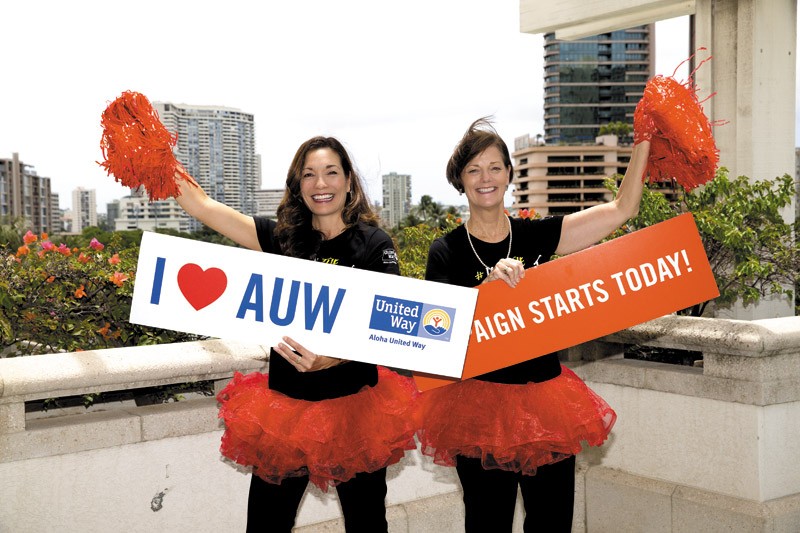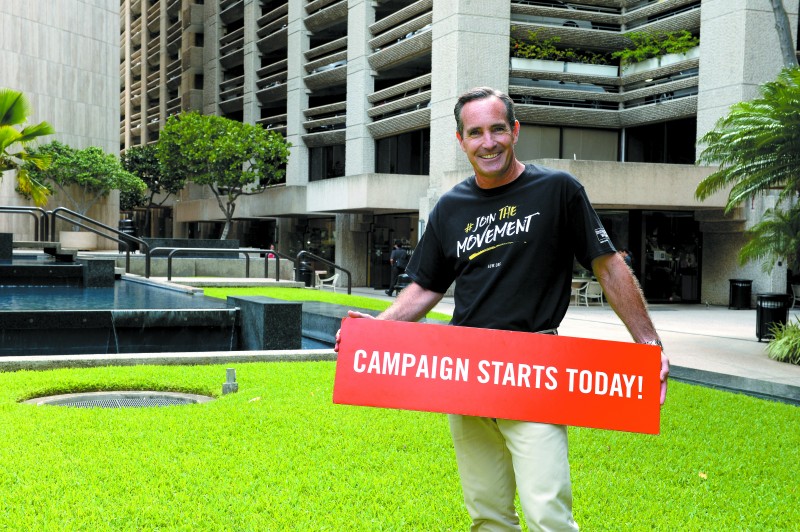Way To Go!

Terri Orton, general manager of Hawaii Convention Center, and Kelly Hoen, GM of The Modern Honolulu, are co-chairwomen and head cheerleaders for this year’s Aloha United Way campaign. ANTHONY CONSILLIO PHOTO
East side, West side, all around the town, folks are joining a movement. No, it’s not Pokemon Go. It’s Hawaii’s well-established real-world interaction called Aloha United Way.
This powerful community force brings people together for a common cause and shows what can be accomplished seamlessly and willingly when hearts and minds are aligned.
Oh, if only public works projects (hello, rail) and political campaigns worked the same way!
Aloha United Way (AUW) has been our charity standard bearer for 97 years. That says a lot about its validity and value.
As this year’s campaign chairman Dustin Sellers puts it, “Aloha United Way is part of the kamaaina DNA. It is the first philanthropic organization most islanders come in contact with through their workplace or schools.
“It’s a given,” he adds. “Of course you help the AUW. It helps Hawaii.”
As the state’s largest and most-recognized nonprofit organization, its clout is colossal. Only the most naïve corporate or social climber would turn down an opportunity to serve on its board or campaign committee.
As a matter of fact, astute power players yearn to be tapped for duty. Appointment means, eh, you somebody.
Look at its legacy of campaign leaders and you’ll see the who’s who of local business, industry and spheres of influence. The emergence of “young turks” brings Generations X and Y, like Sellers, who join the rallying cry on behalf of 342 social service agencies.

Dustin Sellers of Koa Capital Partners, chairman of this year’s AUW campaign, invites you to ‘Join The Movement’
NATHALIE WALKER PHOTO
If there were no AUW, citizens would be subjected to year-round fundraising pleas from 342 separate agencies. Auwe.
Fortunately, in 1919 the concept of united community giving was introduced. United Way is the pioneer of workforce fundraising, where company employees donate directly from their paychecks. Solicitation takes place once a year — August through October — and allows agencies to focus on what they should be doing: helping people.
This year’s AUW campaign goal is $9.3 million. Last year, it invested $11.6 million into the community, touching more than 830,000 residents.
According to Cindy Adams, AUW president-CEO, there are three impact areas: education, poverty prevention including reducing homelessness, and safety net.
Its 2-1-1 information and referral hot line annually connects more than 59,000 callers experiencing crisis to nonprofit services.
In addition, “AUW has distributed more than $900,000 to 18 service providers across the state who aid homeless individuals and families and those on the brink of homelessness,” she says. “We provide them with financial assistance toward rent, as well as stabilization services such as mediation, credit counseling and case management.”
At a time when transparency and accountability are vital, AUW closely monitors community impact goals, progress and financials of its partner agencies.
That follows a trend called “collective impact” defined by the National Council on Nonprofits as “an intentional way of working together and sharing information for the purpose of solving complex problems.”
“The complex nature of most social problems belies the idea that any single program or organization, however well managed and funded, can singlehandedly create lasting large-scale change,” it cites.
Sellers offers another consideration where Hawaii is concerned.
“Among the challenges that Hawaii has is a gap in leadership from the brain drain of the ’90s. There is a gap in both business and philanthropic leadership.
“Ex-pats and returning residents have to be re-educated and reconnected to the community. Partnering with AUW galvanizes it,” he suggests.
As head of private equity investment firm Koa Capital Partners, Sellers is able to bring young entrepreneurs into philanthropic investment through the AUW.
“I’m a connector,” he hails. Also embracing the connector role are campaign co-chairwomen Kelly Hoen, general manager of The Modern Honolulu, and Terri Orton, general manager of Hawaii Convention Center.
Their connection to the hospitality industry, where a sizable part of Oahu’s workforce is found, enhances a Hawaii Lodging & Tourism Association (HLTA) collaboration.
“While hotels have done internal campaigns for many years, the industry effort is strengthened in a collective effort,” Hoen says.
Orton adds, “It is exciting to be rejoining our colleagues in a large-scale campaign. It’s awesome to see new and even boutique properties participating.”
In addition to campaign duties, Hoen and Orton serve on the AUW board of directors, lending their voices and industry knowledge to strategic planning.
“I’ve been fortunate to be in the hospitality industry all of my life,” Hoen reflects. “I grew up with AUW. My dad (Paul Banks, former president of Hawaiian Dredging & Construction Co.) led many campaigns.”
Orton, whose career includes stints at Outrigger Enterprises and Starwood Hotels, lauds tourism’s high-profile philanthropy through the Visitor Industry Charity Walk and AUW.
“These are the doubleheaders that workers anticipate every year,” she says.
AUW’s kickoff events will be staged at Oahu’s largest workforce hubs in downtown Honolulu and Waikiki. (See box.)
This year’s campaign, titled “Join the Movement,” highlights the difference that AUW is making in the community every day and why every resident has a vital role to play.
At a time when government is struggling with budget cutbacks and limited resources, nonprofits have had to take up the slack. Advocates extol the trend, saying government can’t do everything and that nonprofits are better equipped to deal with the root of social problems and concerns.
As the concept of “collective impact” grows, we will likely see more public-private collaboration to meet the community needs. More than 1,300 companies, organizations and government agencies currently participate in AUW campaigns.
Mobilizing this community-giving infrastructure is United Way’s core competence. Yet the nonprofit leader has its naysayers and critics who say it must evolve from a monolithic workplace-giving model to new-age techniques and messages.
According to AUW officials, 25 percent of donations come from corporate gifts and 75 percent come from employee donations. The trend, they say, has remained stable over the past several years.
But moving into progressive modes, donors are now provided a variety of ways to contribute. This includes online giving, such as e-pledge and website donations, that reduces processing costs.
According to National Philanthropic Trust (NPT), in 2013, 100 of the largest charities reported receiving 13 percent more in online donations, and 25 of these charities collected more than $10 million each in 2013 from online gifts.
Philanthropy is its own economic engine. It is estimated that between $6.6 trillion and $27.4 trillion in charitable bequests will be made between 1998 and 2052.
NPT estimates charitable contributions will total $21.2 to $55.4 trillion between 1998-2052.
By the year 2055, some $41 trillion will change hands as Americans pass on their accumulated assets to the next generation.
Where will AUW fit in this massive community giving picture? Only time will tell, but its nearly 100 years of operating in Hawaii (separate from Neighbor Island campaigns) is a heritage that seemingly has built-in loyalty and sustainability.
As campaign chairman Sellers expresses it, “AUW is one of the better ways to give back to the community. Over the years, it has made great strides to connect with the business and corporate giving community.
“It’s exciting and encouraging to see what AUW could be again. It is resilient at a time when the need is great. There is no greater return on our dollar.”
Sellers, Hoen and Orton, cheerleaders for this year’s campaign, are banking on it.
CAMPAIGN KICKOFF EVENTS
Aloha United Way’s 2016 campaign runs Aug. 15-Oct. 7. Its kickoff event is Friday, Aug. 26, 6-9 a.m., at Tamarind Park in downtown Honolulu. Join campaign chairman Dustin Sellers and hundreds of sign-wavers along King and Bishop streets to raise awareness and encourage community participation.
Hawaii Lodging & Tourism Association (HLTA)-AUW campaign launches Tuesday, Aug. 30, 4-5 p.m., at Royal Hawaiian Center Royal Grove. Rally with co-chairwomen Kelly Hoen and Terri Orton, plus hundreds of hospitality workers as they start the Waikiki fundraising effort, with entertainment, prizes and presentations.
Public is invited to both events. Visit auw.org. Social media hashtag is: #JoinTheMovement.






